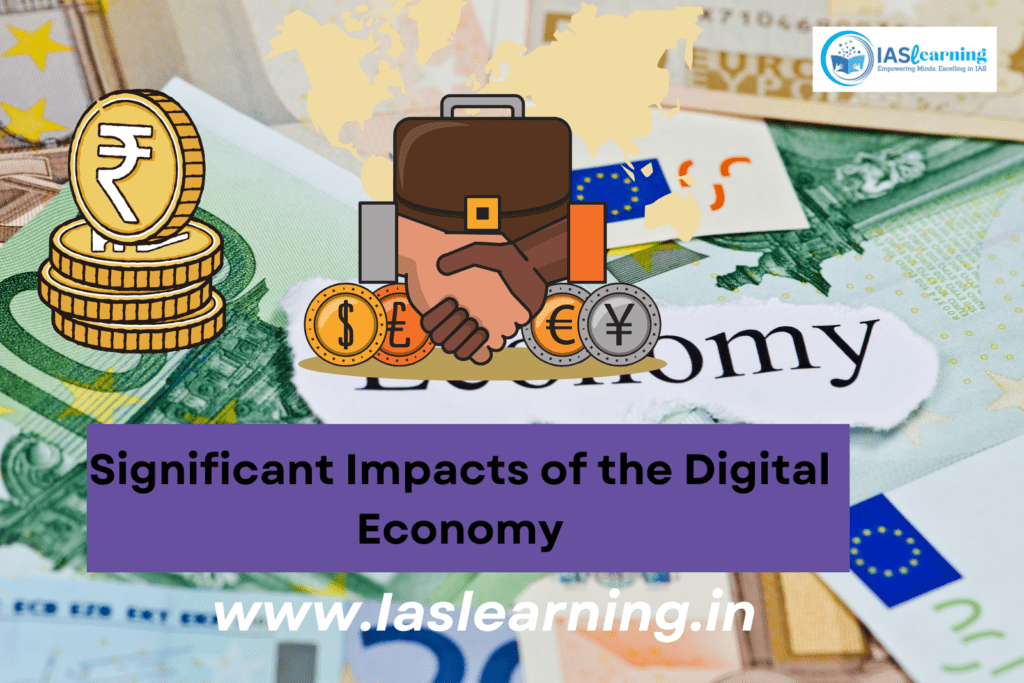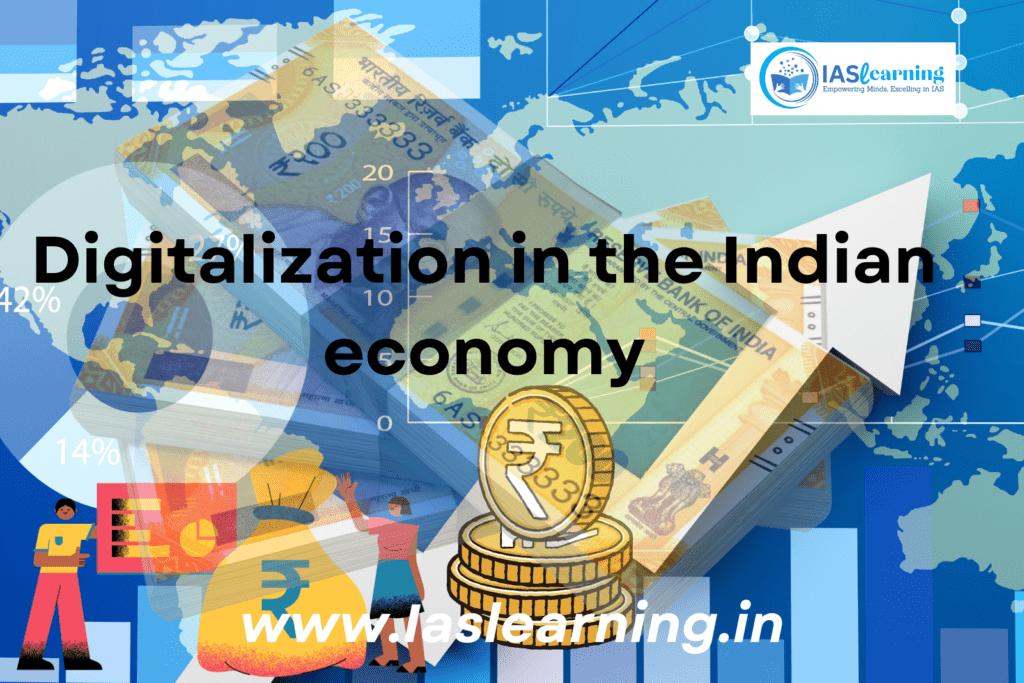Table of Contents
Introduction: Digitalization in the Indian economy
The Indian government has placed a significant emphasis on the digitalization of the nation’s economy as a catalyst for accelerated socio-economic development. In pursuit of this goal, the government initiated the “Digital India” campaign, aimed at expediting the digital transformation of India. This comprehensive program is designed to harness the power of technology to drive economic growth, empower citizens, and enhance the country’s global standing in the digital age.
Status of Digitalization:

- Access to High-Speed Internet: Over 84 crore people have access to affordable, high-speed 4G internet services via mobile telephony, facilitating digital connectivity across the country.
- Aadhar as Unique Identity: Aadhar has been pivotal, providing over 99% of the population with a unique identity, simplifying access to government services and promoting financial inclusion.
- Citizens’ Digital Storage: The ability to securely store documents, certificates, and personal data on public cloud services has become a reality, offering convenience and accessibility.
- Digital Public Infrastructure: The emergence of Digital Public Infrastructure has made government services accessible digitally, with platforms such as UPI, OCEN, Account Aggregators, GST, UMANG, ONDC, and OpenForge providing services ranging from digital payments and credit disbursement to tax filing and e-governance.

Concerns with India’s Digitalization:
- Digital Divide: A significant digital divide persists, disproportionately affecting rural areas, speakers of less common languages, and those with lower levels of education, limiting their access to digital resources.
- Data Protection Laws: The absence of a comprehensive data protection law poses concerns about the security and privacy of individuals’ digital information.
- Cybersecurity and Fraud: The increasing threat of cyberattacks and cyber frauds presents challenges in safeguarding digital infrastructure and user data.
- Broadband Access: The lack of widespread access to affordable broadband internet restricts the digitalization of remote and underserved areas.
- Semiconductor Industry Dependency: India’s dependence on semiconductor imports highlights the need for a domestic semiconductor industry, enhancing self-reliance and security in critical technology sectors.
Conclusion:
To further accelerate India’s digitalization and ensure it is inclusive and secure, the following suggestions are imperative:
- Digital Infrastructure Expansion: Substantial investments should be made in expanding digital infrastructure to bridge the urban-rural digital divide and enhance connectivity in underserved regions.
- Digital Literacy Programs: Nationwide digital literacy programs are essential to ensure that every citizen, regardless of education or location, can leverage the benefits of digitalization.
- Cybersecurity Enhancement: Strengthening cybersecurity measures and launching awareness campaigns are critical to protect users from evolving online threats.
- Startup Ecosystem: Promoting the growth of startups, especially in emerging technology sectors, can foster innovation and economic growth.
- Tailored Digital Payments: Tailored digital payment solutions for diverse user groups can facilitate digital financial inclusion.
- Public-Private Collaboration: Collaboration with private sector companies is vital to drive digitalization initiatives, leveraging resources, expertise, and technology for sustainable progress in India’s digital journey.

Additional information
- Digital Payments: The UPI-based BHIM app has gained widespread popularity, with UPI transactions surpassing 10 billion monthly transactions in August 2023, amounting to INR 18 trillion (USD 204.77 billion). This demonstrates the rapid adoption of digital payment solutions.
- E-Governance: The Digital India program has made substantial advancements in providing e-governance services. Initiatives like e-visa and the Digital Locker system have simplified government services, reduced paperwork, and improved accessibility.
- E-commerce: India’s e-commerce market is set to reach $200 billion by 2026. Major players like Flipkart and Amazon have expanded their presence, and the COVID-19 pandemic accelerated the shift to online shopping.
- Startup Ecosystem: India has witnessed the emergence of a thriving startup ecosystem, with 110 unicorn startups valued at a collective $347 billion. These startups, including Paytm, Ola, and Zomato, highlight India’s potential as a technology-driven entrepreneurial hub.
- Financial Inclusion: Digital financial services have enhanced financial inclusion by providing banking access to the unbanked and underbanked. Initiatives like Jan Dhan Yojana have led to the opening of millions of new bank accounts, promoting financial inclusion.
- Broadband and Internet Usage: India has seen a significant increase in broadband adoption, with 765 million mobile broadband subscribers as of 2021. This surge has resulted in a substantial rise in data consumption per individual, with the younger generation dedicating approximately 8 hours daily to online activities.
These developments signify India’s evolving digital landscape, fostering economic growth, accessibility, and innovation in the digital era.

